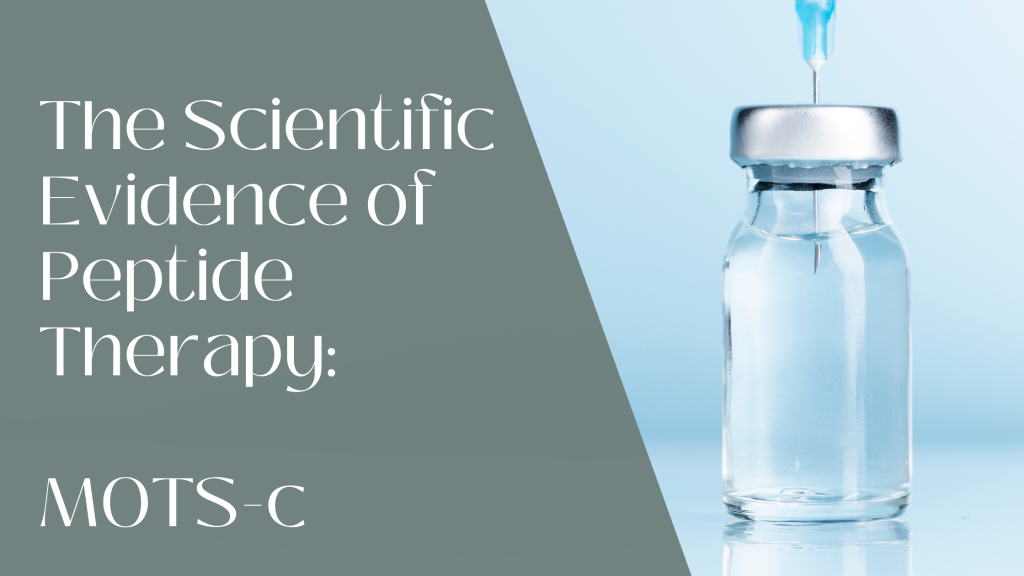The Scientific Evidence of Peptide Therapy: MOTS-c

MOTS-c is a 16-amino acid peptide encoded by a mitochondrial gene, playing a role in regulating metabolism and promoting physical performance. It’s considered an “exercise-mimetic” because it can improve glucose uptake in skeletal muscle and enhance insulin sensitivity without requiring insulin. While research suggests potential benefits for metabolic health and physical performance, it’s not yet widely used clinically and some studies indicate potential side effects. In this article we will review the potential benefits and risks in various domains, including longevity, cognitive and brain health, and possibly athletic performance.
Longevity: MOTS-c has been implicated in promoting healthy aging by enhancing metabolic fitness and physical capacity. It regulates nuclear genes related to metabolism and proteostasis,and improves skeletal muscle metabolism and myoblast adaptation to metabolic stress. Studies in mice have shown that MOTS-c treatment can increase physical capacity and healthspan, suggesting its role in mitigating age-dependent physical decline.1,2
Cognitive and Brain Health: MOTS-c has demonstrated neuroprotective effects. It enhances memory and attenuates memory impairment induced by amyloid-beta (Aβ) or lipopolysaccharide (LPS) through the inhibition of neuroinflammation. The peptide increases the phosphorylation of AMPK in the hippocampus, which is associated with improved cognitive function. Peripheral administration of a cell-penetrating MOTS-c analogue has shown promising results in enhancing memory and reducing neuroinflammation.3
Athletic Performance: MOTS-c is exercise-induced and has been shown to enhance physical performance in both young and aged mice. It improves exercise capacity and leads to adaptations similar to those observed with physical activity, such as weight loss, increased antioxidant capacity, and improved insulin sensitivity. These findings suggest that MOTS-c may act as an exercise mimetic, enhancing physical performance and metabolic health.4
Evaluation in Breast Cancer Survivors: In a study by Dieli-Conwright et al. (2021), a 16-week aerobic and resistance exercise intervention was evaluated visavis MOTS-c levels in breast cancer survivors. The study found that post-exercise, MOTS-c levels significantly increased in non-Hispanic White breast cancer survivors but not in Hispanic breast cancer survivors. The increase in MOTS-c levels among non-Hispanic White participants was associated with reductions in fat mass, body weight, HOMA-IR, CRP, and an increase in lean mass, indicating improved metabolic profiles.5
Study of MOTS-c and strength: In a study by Domin et al. (2023) in physically active healthy volunteers, higher serum MOTS-c concentrations were positively correlated with greater muscle mass, force, and power generated during jumping exercises, but not with maximal oxygen uptake (VO2). This suggests that MOTS-c is more closely associated with measures of muscle strength rather than endurance in physically active individuals.6
Taken together, data on MOTS-c represents a compelling, though still nascent, therapeutic candidate at the intersection of metabolism, aging, and performance. Its ability to mimic some of the key biochemical signatures of exercise—improved glucose uptake, enhanced mitochondrial function, increased AMPK activity—makes it particularly intriguing for those interested in healthspan optimization. Early preclinical data suggest potential applications across multiple domains, including delaying age-related physical decline, enhancing cognitive resilience through neuroinflammatory modulation, and augmenting exercise capacity. But as with any emerging intervention, enthusiasm should be tempered with caution: human data are limited, and we have much to learn about long-term efficacy, safety, and ideal delivery mechanisms. In this article, we’ll explore the mechanistic underpinnings of MOTS-c and critically examine the evidence across its possible use cases—from longevity and neuroprotection to athletic performance—through the lens of translational medicine.
Citations
- Lee, C., et al. “MOTS-c: A Mitochondrial-Encoded Regulator of the Metabolic Syndrome.” Trends in Endocrinology & Metabolism 26, no. 8 (2015): 428-435. https://doi.org/10.1016/j.tem.2015.05.002.
- Kim, K. H., and J. S. Lee. “MOTS-c: A Novel Mitochondrial-Derived Peptide Regulating Muscle and Fat Metabolism.” Journal of Molecular Endocrinology 56, no. 3 (2016): 159-168. https://doi.org/10.1530/JME-15-0316.
- Jiang, J., et al. 2021. “Peripheral Administration of a Cell-Penetrating MOTS-c Analogue Enhances Memory and Attenuates Aβ- Or LPS-Induced Memory Impairment Through Inhibiting Neuroinflammation.” ACS Chemical Neuroscience 12 (9): 1506–1518. https://doi.org/10.1021/acschemneuro.0c00782.
- J. S. T. Woodhead and T. L. Merry, “Mitochondrial-Derived Peptides and Exercise,” Biochimica et Biophysica Acta – General Subjects 1865, no. 12 (2021): 130011, https://doi.org/10.1016/j.bbagen.2021.130011.
- Dieli-Conwright, C. M., et al. 2021. “Effect of Aerobic and Resistance Exercise on the Mitochondrial Peptide MOTS-c in Hispanic and Non-Hispanic White Breast Cancer Survivors.” Scientific Reports 11 (1): 16916. https://doi.org/10.1038/s41598-021-96419-z.
- Domin, R., et al. 2023. “MOTS-c Serum Concentration Positively Correlates With Lower-Body Muscle Strength and Is Not Related to Maximal Oxygen Uptake—a Preliminary Study.” International Journal of Molecular Sciences 24 (19): 14951. https://doi.org/10.3390/ijms241914951.